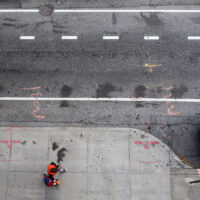Is Prior Notice Required to Hold the City Liable for a Trip and Fall on a Damaged Sidewalk?

If you tripped and fell on a broken or uneven sidewalk in New York City, you may assume the City is automatically responsible for your injuries. After all, the sidewalk is public property. But under New York law, holding the City liable for a sidewalk defect is not that simple. One of the biggest hurdles injury victims face in these cases is the City’s prior written notice requirement. If you’ve been hurt in a trip and fall on a damaged sidewalk in Manhattan, Queens, Brooklyn or the Bronx, get the legal help you need by contacting Leandros A. Vrionedes, P.C., to work with a skilled and dedicated NYC sidewalk trip and fall lawyer.
What the Law Says About Prior Written Notice
New York City Administrative Code §7-201(c)(2) states that the City cannot be held liable for injuries caused by sidewalk defects—such as cracks, holes, or uneven pavement—unless it had prior written notice of the specific defect that caused the accident. That means the City must have received written notice about the dangerous condition before your fall occurred. Without that notice, your claim against the City will likely be dismissed, even if the sidewalk was clearly unsafe.
How the City Receives Prior Notice
Sources of written notice might include:
- A complaint or report made directly to the City’s DOT or another municipal agency
- A notice of claim filed for a prior incident at the same location
- A repair order or inspection report identifying the same hazard
However, verbal complaints or general awareness by city employees are not enough. The law requires written notice of the specific defect.
Exceptions to the Prior Notice Requirement
Two important exceptions exist where you may still hold the City liable even without prior written notice:
- Affirmative Negligence: If the City or one of its contractors created the dangerous condition through negligent work—such as an improper repair or construction project—it can still be held liable.
- Special Use: If the sidewalk was being used for a special benefit to the City (for example, for access to a municipal facility), the City may bear responsibility for maintaining it in a safe condition.
These exceptions are strictly applied, so proving them requires solid evidence, such as work orders, permits, or witness testimony linking the City’s own actions to the defect.
Property Owner Liability for Sidewalk Defects
In many cases, the City is not the proper defendant at all. Under NYC Administrative Code §7-210, the owner of the adjacent property, whether a business, apartment building, or other private entity, is responsible for maintaining the sidewalk abutting their property. This includes repairing cracks, uneven slabs, and other hazards.
There are a few exceptions, such as sidewalks next to one-, two-, or three-family homes that are wholly or partly owner-occupied and used exclusively for residential purposes. In those cases, the City may still have maintenance responsibility. Sidewalks abutting city property are the responsibility of the City as well.
Determining who owns or maintains the stretch of sidewalk where your accident happened is a critical first step in any claim.
Proving Notice and Negligence
Even if prior notice exists, you must still prove the City or property owner was negligent. That typically means showing they failed to take reasonable steps to repair or warn about the defect within a reasonable period of time. Photographs, inspection records, and witness statements are often vital pieces of evidence in proving liability.
Because of New York’s comparative fault rule, your own actions may also come under scrutiny. If the City or property owner can show you were partially responsible—for example, by not watching where you were walking—your compensation could be reduced in proportion to your share of fault.
Why Legal Representation Matters
Trip and fall claims involving the City of New York have strict procedural rules, including short deadlines. You must file a Notice of Claim with the City within 90 days of your accident before you can file a lawsuit. Missing that deadline can bar your claim entirely.
An experienced New York premises liability attorney can:
- Investigate the accident site and determine who is legally responsible
- Review government records to establish prior written notice
- File your Notice of Claim on time and preserve your right to compensation
- Build a strong case proving the City or property owner’s negligence
- Push back against unfounded allegations of comparative negligence
Talk to a New York Sidewalk Accident Lawyer
If you suffered injuries in a sidewalk trip and fall accident, don’t assume the City—or anyone else—will voluntarily take responsibility. Proving liability in these cases often requires in-depth legal knowledge and thorough investigation.
At Leandros A. Vrionedes, P.C., we know how to navigate New York’s complex sidewalk liability laws and fight for maximum compensation for our clients. Contact our office today to discuss your case and learn your rights after a sidewalk fall in NYC.


